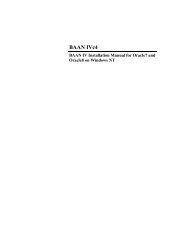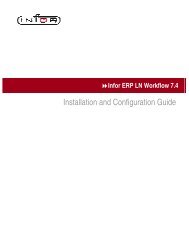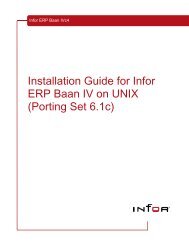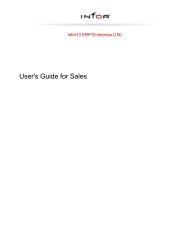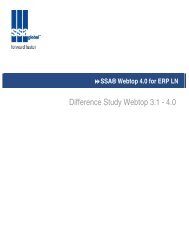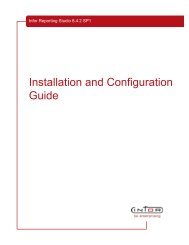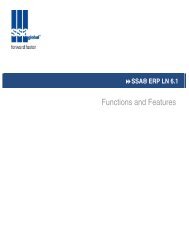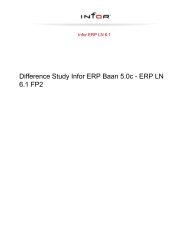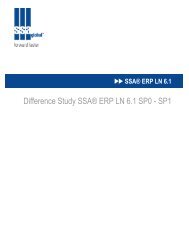Allocation and Hard Pegging - Baan Implementation Help ...
Allocation and Hard Pegging - Baan Implementation Help ...
Allocation and Hard Pegging - Baan Implementation Help ...
You also want an ePaper? Increase the reach of your titles
YUMPU automatically turns print PDFs into web optimized ePapers that Google loves.
Infor ERP LN 6.1 FP5<br />
User's Guide for <strong>Allocation</strong> <strong>and</strong><br />
<strong>Hard</strong> <strong>Pegging</strong>
© Copyright 2008 Infor<br />
All rights reserved. The word <strong>and</strong> design marks set forth herein are trademarks <strong>and</strong>/or registered trademarks of Infor<br />
<strong>and</strong>/or its affiliates <strong>and</strong> subsidiaries. All rights reserved. All other trademarks listed herein are the property of their respective<br />
owners.<br />
Important Notices<br />
The material contained in this publication (including any supplementary information) constitutes <strong>and</strong> contains confidential<br />
<strong>and</strong> proprietary information of Infor.<br />
By gaining access to the attached, you acknowledge <strong>and</strong> agree that the material (including any modification, translation<br />
or adaptation of the material) <strong>and</strong> all copyright, trade secrets <strong>and</strong> all other right, title <strong>and</strong> interest therein, are the sole<br />
property of Infor <strong>and</strong> that you shall not gain right, title or interest in the material (including any modification, translation or<br />
adaptation of the material) by virtue of your review thereof other than the non-exclusive right to use the material solely<br />
in connection with <strong>and</strong> the furtherance of your license <strong>and</strong> use of software made available to your company from Infor<br />
pursuant to a separate agreement (“Purpose”).<br />
In addition, by accessing the enclosed material, you acknowledge <strong>and</strong> agree that you are required to maintain such<br />
material in strict confidence <strong>and</strong> that your use of such material is limited to the Purpose described above.<br />
Although Infor has taken due care to ensure that the material included in this publication is accurate <strong>and</strong> complete, Infor<br />
cannot warrant that the information contained in this publication is complete, does not contain typographical or other<br />
errors, or will meet your specific requirements. As such, Infor does not assume <strong>and</strong> hereby disclaims all liability,<br />
consequential or otherwise, for any loss or damage to any person or entity which is caused by or relates to errors or<br />
omissions in this publication (including any supplementary information), whether such errors or omissions result from<br />
negligence, accident or any other cause.<br />
Trademark Acknowledgements<br />
All other company, product, trade or service names referenced may be registered trademarks or trademarks of their<br />
respective owners.<br />
Publication Information<br />
Document code<br />
Release<br />
Publication date<br />
U9500A US<br />
Infor ERP LN 6.1 FP5<br />
November 17, 2008
Table of Contents<br />
About this document<br />
Chapter 1 Overview of allocation <strong>and</strong> hard pegging....................................................... ..............1-1<br />
<strong>Allocation</strong> <strong>and</strong> hard pegging overview......................................................................... ..............1-1<br />
To set up allocation <strong>and</strong> hard pegging............................................................... ..............1-1<br />
To h<strong>and</strong>le insufficient inventory.......................................................................... ..............1-2<br />
Inventory allocation levels.................................................................................. ..............1-2<br />
To change inventory allocations......................................................................... ..............1-2<br />
Chapter 2 To set up allocation <strong>and</strong> hard pegging............................................................ ..............2-1<br />
To set up allocation <strong>and</strong> hard pegging......................................................................... ..............2-1<br />
Chapter 3 To hard peg supply orders................................................................................ ..............3-1<br />
To hard peg supply orders........................................................................................... ..............3-1<br />
<strong>Hard</strong> peg supply orders in Order Management.................................................. ..............3-1<br />
<strong>Hard</strong> peg supply orders in Warehouse Management........................................ ..............3-2<br />
<strong>Hard</strong> peg supply purchase orders <strong>and</strong> schedules.............................................. ..............3-2<br />
Chapter 4 <strong>Allocation</strong> buffers.............................................................................................. ..............4-1<br />
<strong>Allocation</strong> buffers......................................................................................................... ..............4-1<br />
To calculate available unallocated inventory...................................................... ..............4-1<br />
To create allocation buffers................................................................................ ..............4-2<br />
Chapter 5 Inventory allocation levels................................................................................ ..............5-1<br />
Inventory allocation levels............................................................................................ ..............5-1<br />
<strong>Allocation</strong> levels................................................................................................. ..............5-1<br />
H<strong>and</strong>ling unit setup for allocations..................................................................... ..............5-2<br />
Chapter 6 <strong>Allocation</strong> <strong>and</strong> hard pegging example............................................................. ..............6-1<br />
<strong>Allocation</strong> <strong>and</strong> hard pegging example.......................................................................... ..............6-1<br />
Item S................................................................................................................. ..............6-1<br />
Item H................................................................................................................. ..............6-2
Components C1 <strong>and</strong> C2.................................................................................... ..............6-2<br />
Component C3................................................................................................... ..............6-2<br />
<strong>Allocation</strong> <strong>and</strong> hard pegging data...................................................................... ..............6-3<br />
Appendix A Glossary.......................................................................................................... .............A-1<br />
Index
About this document<br />
Objective<br />
The objective of this guide is to describe allocation <strong>and</strong> hard pegging in ERP<br />
LN.<br />
Intended audience<br />
This document is intended for persons in charge of allocation <strong>and</strong> hard pegging.<br />
The intended audience can include key users, implementation consultants,<br />
product architects, support specialists, <strong>and</strong> so on.<br />
Document summary<br />
Chapter number<br />
Chapter 1<br />
Chapter 2<br />
Chapter 3<br />
Chapter 4<br />
Chapter 5<br />
Chapter 6<br />
Content<br />
An overview of allocation <strong>and</strong> hard pegging<br />
To set up allocation <strong>and</strong> hard pegging<br />
To hard peg supply orders<br />
<strong>Allocation</strong> buffers<br />
How to read this document<br />
Inventory allocation levels<br />
An allocation <strong>and</strong> hard pegging example<br />
This document was assembled from online <strong>Help</strong> topics. As a result, references<br />
to other sections in the manual are presented as shown in the following example:<br />
For details, refer to Introduction. To locate the referred section, please refer to<br />
the Table of Contents or use the Index at the end of the document.<br />
At the end of this document, a glossary is included. Terms explained in the<br />
glossary are presented as shown in the following example:<br />
In Common Data, you can link addresses to business partners.<br />
If you view this document online, you can click these terms to go to the term's<br />
definition in the glossary.
ii | About this document<br />
Customer Support<br />
If you have questions regarding the Infor products described, go to Infor’s<br />
Customer Support portal at www.infor365.com .<br />
▪ To access Infor365, go to www.infor365.com <strong>and</strong> log in. If you do not have<br />
an Infor365 account, click Account Request, complete the registration<br />
form, <strong>and</strong> a login will be sent to you within 24 hours.<br />
▪ To access Infor knowledgebases, documentation, downloads, communities,<br />
<strong>and</strong> incidents, click the appropriate link in the top menu of the home page.<br />
▪ To find your local support phone number, click Contact Infor in the top<br />
right corner of the home page, enter a product name, <strong>and</strong> click Search.
Chapter 1<br />
Overview of allocation <strong>and</strong> hard pegging<br />
<strong>Allocation</strong> <strong>and</strong> hard pegging overview<br />
To set up allocation <strong>and</strong> hard pegging<br />
<strong>Allocation</strong> of inventory <strong>and</strong> hard pegging of orders are related methods used to<br />
designate a quantity of supply to a specific purpose.<br />
The allocation <strong>and</strong> hard pegging functionality enables you to do the following:<br />
▪ Promise a customer a particular quantity of an item. The allocated inventory<br />
cannot be shipped to other customers <strong>and</strong> serves as a reservation.<br />
▪ Link an identifiable quantity of an item to a particular dem<strong>and</strong>. In this way,<br />
that particular quantity cannot be interchanged with another quantity of the<br />
same item. For example, you use this to keep components <strong>and</strong><br />
subassemblies together in a subcontracting setup.<br />
The primary purpose of the allocation <strong>and</strong> hard pegging functionality is to link<br />
supply orders to dem<strong>and</strong> orders, or to allocate inventory to a specific dem<strong>and</strong><br />
order. If inventory is allocated or supply is hard pegged to a specific dem<strong>and</strong>, a<br />
lot of processes are involved. For example, hard pegging is taken into account<br />
during order planning, the issuing <strong>and</strong> receipt of materials, the outbound <strong>and</strong><br />
shipment of goods, <strong>and</strong> so on. To enable dem<strong>and</strong> <strong>and</strong> supply matching during<br />
all of these processes, specifications are used.<br />
ERP LN uses specifications to:<br />
▪ <strong>Hard</strong> peg, in other words, to link, a supply order to a dem<strong>and</strong> order<br />
▪ Allocate inventory to a dem<strong>and</strong> order.<br />
1<br />
Before you can use the allocation <strong>and</strong> hard pegging functionality, you must set<br />
up the allocation <strong>and</strong> hard pegging master data. For more information, refer to To<br />
set up allocation <strong>and</strong> hard pegging (p. 2-1)<br />
After the allocation <strong>and</strong> hard pegging data is set up, when a dem<strong>and</strong> order is<br />
created, ERP LN:<br />
▪ Links a specification to the dem<strong>and</strong> order.
1-2 | Overview of allocation <strong>and</strong> hard pegging<br />
▪ Allocates inventory to the dem<strong>and</strong> order.<br />
▪ Updates the quantity of the Allocated-to Inventory Allocated field in<br />
the Allocated-to Inventory (whwmd2519m000) session with the quantity of<br />
the dem<strong>and</strong> order, even if insufficient inventory is available to fulfill the<br />
dem<strong>and</strong> order.<br />
Note<br />
To h<strong>and</strong>le insufficient inventory<br />
Inventory allocation levels<br />
To change inventory allocations<br />
If the dem<strong>and</strong> order is created manually or from independent dem<strong>and</strong>,<br />
specifications are created if the allocation <strong>and</strong> hard pegging terms <strong>and</strong> conditions<br />
are defined. If the dem<strong>and</strong> order is created from dependent dem<strong>and</strong>, the dem<strong>and</strong><br />
order can only receive a specification from the origin that created the order. For<br />
an example of how a specification is transferred between business objects, refer<br />
to <strong>Allocation</strong> <strong>and</strong> hard pegging example (p. 6-1) .<br />
If insufficient inventory is available to fulfil a dem<strong>and</strong> order, you can create supply<br />
orders or allocate inventory.<br />
Supply orders are generated or manually created if insufficient allocated or<br />
unallocated inventory is present to fulfil the dem<strong>and</strong> order. If a supply order is<br />
generated for the dem<strong>and</strong> order, a specification is also generated for the supply<br />
order. This specification has the same characteristics as the specification of the<br />
dem<strong>and</strong> order. For more information, refer to To hard peg supply orders (p. 3-1)<br />
.<br />
Inventory is allocated using allocation buffers if insufficient allocated, but sufficient<br />
unallocated inventory is present. The inventory included in an allocation buffer<br />
is linked to a specification. As a result, the buffered inventory is available for<br />
dem<strong>and</strong> orders with matching specification criteria. For more information, refer<br />
to <strong>Allocation</strong> buffers (p. 4-1) .<br />
Inventory allocation levels determine whether allocated-to inventory is identifiable<br />
<strong>and</strong> traceable in the warehouse by means of h<strong>and</strong>ling units or merely registered<br />
as allocated-to inventory. You can define allocation levels for warehouse - item<br />
combinations in the Warehouse - Item (whwmd2510m000) session <strong>and</strong> the Item<br />
- Warehousing (whwmd4100s000) session.<br />
For more information, refer to Inventory allocation levels (p. 5-1) .<br />
Changing an inventory allocation is required, for example, if the order for which<br />
the inventory is allocated is canceled. To change an allocation, you must use<br />
an allocation change order.
<strong>Allocation</strong> change orders are generated based on a number group <strong>and</strong> series<br />
defined in the Inventory H<strong>and</strong>ling Parameters (whinh0100m000) session.<br />
For more information, refer to:<br />
▪ <strong>Allocation</strong> Change Orders (whinh1120m000)<br />
▪ <strong>Allocation</strong> Change Order Lines (whinh1130m000)<br />
Overview of allocation <strong>and</strong> hard pegging | 1-3
1-4 | Overview of allocation <strong>and</strong> hard pegging
Chapter 2<br />
To set up allocation <strong>and</strong> hard pegging<br />
To set up allocation <strong>and</strong> hard pegging<br />
2<br />
Before you can use the allocation <strong>and</strong> hard pegging functionality, you must set<br />
up the allocation <strong>and</strong> hard pegging master data.<br />
You must define the following master data:<br />
▪ Select the <strong>Allocation</strong> <strong>and</strong> <strong>Hard</strong> <strong>Pegging</strong> check box in the Implemented<br />
Software Components (tccom0500m000) details session.<br />
▪ Set up a terms <strong>and</strong> conditions agreement <strong>and</strong> define the allocation <strong>and</strong><br />
hard pegging terms <strong>and</strong> conditions in the <strong>Allocation</strong> <strong>and</strong> <strong>Hard</strong> <strong>Pegging</strong><br />
Terms <strong>and</strong> Conditions (tctrm1165m000) session.<br />
In the <strong>Allocation</strong> <strong>and</strong> <strong>Hard</strong> <strong>Pegging</strong> Terms <strong>and</strong> Conditions<br />
(tctrm1165m000) session, you must do the following:<br />
▪ Select the <strong>Allocation</strong> <strong>and</strong> <strong>Hard</strong> <strong>Pegging</strong> Required check box.<br />
▪ Select the Use Unallocated Inventory check box if not only allocated<br />
inventory must be used, but also unallocated inventory.<br />
▪ Define the type of allocation <strong>and</strong> hard pegging in the <strong>Allocation</strong> <strong>and</strong> <strong>Hard</strong><br />
<strong>Pegging</strong> Type field, which determines the specification attributes that are<br />
used for dem<strong>and</strong> <strong>and</strong> supply matching. Therefore, the <strong>Allocation</strong> <strong>and</strong> <strong>Hard</strong><br />
<strong>Pegging</strong> Type determines the content of the specification.<br />
The <strong>Allocation</strong> <strong>and</strong> <strong>Hard</strong> <strong>Pegging</strong> Type field can have the following values:<br />
▪ Order Based<br />
This type is used to allocate inventory <strong>and</strong> hard peg orders to a specific<br />
dem<strong>and</strong> order.<br />
▪ Business Partner Based<br />
This type is used to allocate inventory <strong>and</strong> hard peg orders to a specific<br />
business partner.<br />
▪ Customer Reference Based<br />
This type is used to allocate inventory <strong>and</strong> hard peg orders to a specific<br />
customer reference.
2-2 | To set up allocation <strong>and</strong> hard pegging<br />
▪ Internal Reference Based<br />
This type is used to allocate inventory <strong>and</strong> hard peg orders to a specific<br />
internal reference.<br />
<strong>Allocation</strong> <strong>and</strong> <strong>Hard</strong> <strong>Pegging</strong><br />
Type<br />
Business Partner Based<br />
Order Based<br />
Customer Reference Based<br />
Internal Reference Based<br />
Specified in Specification<br />
Business Partner<br />
Business partner<br />
Order/position/sequence<br />
Business partner<br />
Reference<br />
Reference<br />
For more information on terms <strong>and</strong> conditions, refer to Overview of terms <strong>and</strong><br />
conditions.
Chapter 3<br />
To hard peg supply orders<br />
To hard peg supply orders<br />
If insufficient inventory is available, supply orders can be generated <strong>and</strong> hard<br />
pegged to the dem<strong>and</strong> order requesting allocated inventory. This means the<br />
supply order receives the same specification as the dem<strong>and</strong> order. Allocated<br />
planned inventory transactions, containing the specifications, are created for the<br />
supply orders.<br />
Supply orders for dem<strong>and</strong> orders are generated or manually created:<br />
▪ In order planning runs in the Enterprise Planning package. For more<br />
information, refer to Order planning, an overview.<br />
▪ Directly from the sales (dem<strong>and</strong>) order or schedule in the Order<br />
Management package.<br />
<strong>Hard</strong> peg supply orders in Order Management<br />
The following supply orders can be generated:<br />
▪ Supply purchase orders in the Generate Purchase Orders<br />
(tdsls4241m000) session.<br />
▪ Supply production orders in the Generate Production Orders<br />
(tdsls4243m000) session.<br />
▪ Supply transfer orders in the Transfer Order for Sales Order<br />
(tdsls4242s000) session.<br />
3<br />
Supply orders can be created as follows from the Sales Order Lines<br />
(tdsls4101m000) session, or the Sales Order Delivery Lines<br />
(tdsls4101m100) session:<br />
▪ Manually from the stock shortage menu<br />
When an inventory shortage occurs on the order line, the Inventory Shortage<br />
Menu (tdsls4830s000) session is started. Select Generate Purchase<br />
Order, Generate Production Order, or Generate Transfer Order to create<br />
a supply order in the relevant session.
3-2 | To hard peg supply orders<br />
▪ Manually from the Specific menu<br />
When an inventory shortage occurs on the order line, you can click Generate<br />
Purchase Order, Generate Production Order, or Generate Transfer<br />
Order on the Specific menu to create a supply order in the relevant session.<br />
▪ Automatically at sales order line entry<br />
When an inventory shortage occurs, a supply order is automatically<br />
generated if the relevant session is linked as an automatic activity to the<br />
order type in the Sales Order Type - Activities (tdsls0694m000) session.<br />
Note<br />
▪ The Inventory Shortage Menu (tdsls4830s000) session, which can appear<br />
for a manually entered sales order, is only started if the total quantity of the<br />
allocated inventory <strong>and</strong>/or hard pegged supply orders is less than the sales<br />
order line's ordered quantity.<br />
▪ During BOM explosion of the production order, ERP LN can propagate the<br />
hard peg to orders for components, depending on the <strong>Hard</strong> Peg<br />
Propagation field in the Bill of Material (tibom1110m000) session.<br />
<strong>Hard</strong> peg supply orders in Warehouse Management<br />
Warehouse Management parameter settings determine the following:<br />
▪ Whether items received by supply orders become identifiable in inventory<br />
through h<strong>and</strong>ling units generated for the receipts line of the supply order<br />
when the receipt is confirmed. These h<strong>and</strong>ling units obtain specifications<br />
with characteristics identical to those of the supply order.<br />
▪ Whether specific h<strong>and</strong>ling units or anonymous allocated inventory is issued<br />
when generating outbound advice for the dem<strong>and</strong> order. ERP LN issues<br />
inventory whose specification characteristics match those of the outbound<br />
order lines of the dem<strong>and</strong> order.<br />
For more information on these parameter settings, refer to Inventory allocation<br />
levels (p. 5-1) .<br />
<strong>Hard</strong> peg supply purchase orders <strong>and</strong> schedules<br />
A purchase order/schedule is a source of supply for items. By means of the<br />
specification, items that you purchase can be hard pegged to an allocated<br />
dem<strong>and</strong>. During receipt of the item, the hard pegging characteristics of the<br />
specification are copied to the inventory record, which allocates this inventory<br />
to the specific dem<strong>and</strong>.
Purchase orders<br />
To hard peg supply orders | 3-3<br />
A purchase order line can receive a hard peg if it is generated from the following<br />
origins:<br />
▪ EDI<br />
The purchase order line <strong>and</strong> related specification information is<br />
communicated by means of electronic data interchange (EDI). This applies<br />
if the Supply Planning by Supplier check box is selected in the Planning<br />
Terms <strong>and</strong> Conditions (tctrm1135m000) session. As a result, the <strong>Allocation</strong><br />
<strong>and</strong> <strong>Hard</strong> <strong>Pegging</strong> Type in the <strong>Allocation</strong> <strong>and</strong> <strong>Hard</strong> <strong>Pegging</strong> Terms <strong>and</strong><br />
Conditions (tctrm1165m000) session determines the specification's<br />
appearance on the purchase order line.<br />
▪ Sales<br />
The purchase order is generated in the Generate Purchase Orders<br />
(tdsls4241m000) session. If a specification is linked to the sales order <strong>and</strong><br />
the Supply Planning by Supplier check box is cleared in the Planning<br />
Terms <strong>and</strong> Conditions (tctrm1135m000) session, the specification of the<br />
sales order is copied to the purchase order line.<br />
▪ EP<br />
The purchase order is generated from the Transfer Planned Orders<br />
(cppat1210m000) session. If a specification is linked to the planned<br />
order <strong>and</strong> the Supply Planning by Supplier check box is cleared in<br />
the Planning Terms <strong>and</strong> Conditions (tctrm1135m000) session, the<br />
specification of the planned order is copied to the purchase order line.<br />
▪ Warehousing<br />
The purchase order is generated from the Generate Orders (TPOP)<br />
(whinh2201m000) session. If a specification is linked to the planned<br />
inventory transaction <strong>and</strong> the Supply Planning by Supplier check box is<br />
cleared in the Planning Terms <strong>and</strong> Conditions (tctrm1135m000) session,<br />
the specification of the planned inventory transaction is copied to the<br />
purchase order line.<br />
▪ Warehousing Receipt<br />
The purchase order line is generated automatically for an unexpected<br />
warehouse receipt. The specification is copied from the receipt in Warehouse<br />
Management.<br />
▪ SFC<br />
The (subcontracting) purchase order line is created from the Generate<br />
Subcontracting Purchase Orders (tisfc2250m000) session for a<br />
subcontracted operation on a production order. The specification is copied<br />
from the Estimated Materials (ticst0101m000) session in Manufacturing to<br />
the Purchase Order Material Supply Lines (tdpur4116m000) session in Order<br />
Management.<br />
▪ Subcontracting Purchase Order<br />
The (subcontracting) purchase order line is created from the Generate<br />
Supply Orders for Subcontracting (tdpur4216m000) session for an order
3-4 | To hard peg supply orders<br />
controlled/single system. The specification from the Purchase Order Material<br />
Supply Lines (tdpur4116m000) session is copied to the purchase order<br />
line.<br />
▪ Manual<br />
For manually entered purchase orders, you can only create a specification<br />
in a specific vendor managed inventory (VMI) scenario <strong>and</strong> a<br />
specific subcontracting scenario.<br />
Before you can manually enter a purchase order for these scenarios, the<br />
following check boxes must be selected:<br />
▪ Supply Planning by Supplier in the Planning Terms <strong>and</strong> Conditions<br />
(tctrm1135m000) session.<br />
▪ <strong>Allocation</strong> <strong>and</strong> <strong>Hard</strong> <strong>Pegging</strong> Required in the <strong>Allocation</strong> <strong>and</strong> <strong>Hard</strong><br />
<strong>Pegging</strong> Terms <strong>and</strong> Conditions (tctrm1165m000) session.<br />
Note<br />
Both scenarios also require specific settings before you can manually enter<br />
purchase orders:<br />
▪ VMI scenario<br />
On the purchase order line, the Payment field must be set to Pay on<br />
Receipt or Pay on Use.<br />
▪ In the Planning Terms <strong>and</strong> Conditions (tctrm1135m000) session,<br />
the Send Reference to Supplier check box must be selected.<br />
▪ In the <strong>Allocation</strong> <strong>and</strong> <strong>Hard</strong> <strong>Pegging</strong> Terms <strong>and</strong> Conditions<br />
(tctrm1165m000) session, the <strong>Allocation</strong> <strong>and</strong> <strong>Hard</strong> <strong>Pegging</strong> Type must<br />
be set to Internal Reference Based.<br />
▪ Subcontracting scenario<br />
On the purchase order line, the Payment field must be set to No<br />
Payment.<br />
▪ In the <strong>Allocation</strong> <strong>and</strong> <strong>Hard</strong> <strong>Pegging</strong> Terms <strong>and</strong> Conditions<br />
(tctrm1165m000) session, the <strong>Allocation</strong> <strong>and</strong> <strong>Hard</strong> <strong>Pegging</strong> Type must<br />
be set to Business Partner Based or Customer Reference Based.<br />
If the purchase order line is a return order line, the specification of the original<br />
purchase order line is copied to the return order line.<br />
Purchase schedules<br />
A purchase schedule line can receive a hard peg if it is generated from the<br />
following origins:<br />
▪ Warehousing<br />
The purchase schedule is generated from the Generate Orders (TPOP)<br />
(whinh2201m000) session. If a specification is linked to the planned<br />
inventory transaction <strong>and</strong> the Supply Planning by Supplier check box is<br />
cleared in the Planning Terms <strong>and</strong> Conditions (tctrm1135m000) session,
the specification of the planned inventory transaction is copied to the<br />
purchase schedule line.<br />
▪ Subcontracting Purchase Order<br />
The (subcontracting) purchase schedule line is created from the Generate<br />
Supply Orders for Subcontracting (tdpur4216m000) session for an order<br />
controlled/single system. The specification from the Purchase Order Material<br />
Supply Lines (tdpur4116m000) session is copied to the purchase schedule<br />
line.<br />
Note<br />
For push schedules, specifications are not used.<br />
To hard peg supply orders | 3-5
3-6 | To hard peg supply orders
Chapter 4<br />
<strong>Allocation</strong> buffers<br />
<strong>Allocation</strong> buffers<br />
You can use allocation buffers to allocate free, (unallocated) inventory if<br />
insufficient inventory is present.<br />
When you create an allocation buffer, free on h<strong>and</strong> inventory for a warehouse,<br />
item <strong>and</strong>, if present, an effectivity unit, is allocated to a specification. The inventory<br />
is then consumable for outbound order lines whose specification characteristics<br />
match those of the allocation buffer. Outbound order lines, advice lines, shipment<br />
lines, <strong>and</strong> so on, created in the outbound <strong>and</strong> shipment procedures obtain the<br />
specification characteristics of the dem<strong>and</strong> order from which they originate.<br />
You can only create allocation buffers if the following applies:<br />
▪ The Use Unallocated Inventory check box is selected in the <strong>Allocation</strong><br />
<strong>and</strong> <strong>Hard</strong> <strong>Pegging</strong> Terms <strong>and</strong> Conditions (tctrm1165m000) session.<br />
▪ Unallocated inventory is available.<br />
Note<br />
<strong>Allocation</strong> buffers are generated based on a number group <strong>and</strong> series defined<br />
in the Inventory Planning Parameters (whinp0100m000) session.<br />
To calculate available unallocated inventory<br />
ERP LN calculates the available unallocated inventory as follows:<br />
{A - (B + C + D)} + E = F<br />
If F > G, G = unallocated available inventory<br />
H - I = G<br />
4
4-2 | <strong>Allocation</strong> buffers<br />
Symbol<br />
A<br />
B<br />
C<br />
D<br />
E<br />
F<br />
H<br />
To create allocation buffers<br />
I<br />
Value of field in Inventory by Warehouse, Item <strong>and</strong> Effectivity Unit<br />
(whwmd2516m000) session:<br />
Inventory on H<strong>and</strong><br />
Blocked<br />
Committed<br />
Location Allocated<br />
Inventory Committed in Process<br />
Intermediate result<br />
Inventory on H<strong>and</strong> field of the Inventory by Warehouse, Item <strong>and</strong><br />
Effectivity Unit (whwmd2516m000) session<br />
Allocated-to Inventory on H<strong>and</strong> field in the Allocated-to Inventory<br />
(whwmd2519m000) session<br />
The committed inventory C <strong>and</strong> the location allocated inventory D can overlap,<br />
because if outbound advice is created for committed inventory, this advised<br />
committed inventory is listed as both committed <strong>and</strong> location allocated inventory.<br />
If C <strong>and</strong> D were subtracted from A to calculate F, the calculated free inventory<br />
F would be lower than the actual free inventory. Therefore, the inventory<br />
committed in process E is added to balance the result.<br />
If F is more than the difference between the Inventory on H<strong>and</strong> field of<br />
the Inventory by Warehouse, Item <strong>and</strong> Effectivity Unit (whwmd2516m000) session<br />
<strong>and</strong> the Allocated-to Inventory on H<strong>and</strong> field in the Allocated-to Inventory<br />
(whwmd2519m000) session, the result is adjusted to this difference.<br />
<strong>Allocation</strong> buffers are created:<br />
▪ During an order planning run in Enterprise Planning. For more information,<br />
refer to Creating allocation buffers in Enterprise Planning (p. 4-3) .<br />
▪ At sales order line entry (the sales order line being the dem<strong>and</strong> order). The<br />
allocation buffer is created for the warehouse, item, effectivity unit, <strong>and</strong><br />
specification of the sales order line. For more information, refer to Creating<br />
allocation buffers at sales order line entry (p. 4-3) .
▪ Manually in the Inventory Commitments (whinp2100m000) session.<br />
You can view allocation buffers in the Inventory Commitments<br />
(whinp2100m000) session.<br />
Creating allocation buffers in Enterprise Planning<br />
During an order planning run, Enterprise Planning can create allocation buffers<br />
to allocate inventory to a dem<strong>and</strong> order.<br />
To allocate inventory:<br />
1. ERP LN checks whether unallocated inventory is available for the item,<br />
warehouse, <strong>and</strong> specification of the dem<strong>and</strong> order.<br />
2. If no, no allocation takes place.<br />
3. If yes, ERP LN looks for allocation buffers without outbound advice whose<br />
specification characteristics match those of the dem<strong>and</strong> order.<br />
4. If found, the quantity of the existing allocation buffer is increased with the<br />
quantity required for the dem<strong>and</strong> order <strong>and</strong> the quantity of the unallocated<br />
inventory is reduced by the dem<strong>and</strong> order quantity.<br />
5. If not found, ERP LN creates a new allocation buffer with a specification<br />
whose characteristics are identical to those of the dem<strong>and</strong> order. The<br />
quantity of the new allocation buffer matches the dem<strong>and</strong> order quantity.<br />
In the Allocated-to Inventory (whwmd2519m000) session, the following<br />
fields are increased with the new allocation buffer quantity:<br />
▪ Inventory in <strong>Allocation</strong> Buffer<br />
▪ Allocated-to Inventory on H<strong>and</strong><br />
Creating allocation buffers at sales order line entry<br />
<strong>Allocation</strong> buffers | 4-3<br />
<strong>Allocation</strong> buffers can be created as follows from the Sales Order Lines<br />
(tdsls4101m000) session, or the Sales Order Delivery Lines<br />
(tdsls4101m100) session:<br />
▪ Manually from the stock shortage menu<br />
When an inventory shortage occurs on the order line, the Inventory Shortage<br />
Menu (tdsls4830s000) session is started. Select Create <strong>Allocation</strong> Buffer to<br />
create an allocation buffer in the Create <strong>Allocation</strong> Buffers<br />
(tdsls4813s000) session. The allocation buffer is created when the sales<br />
order line is saved.<br />
▪ Manually in Warehouse Management<br />
You can allocate unallocated inventory in the Inventory Commitments<br />
(whinp2100m000) session. On the Specific menu, click <strong>Allocation</strong><br />
Buffers to start this session <strong>and</strong> enter your data.
4-4 | <strong>Allocation</strong> buffers<br />
▪ Automatically at sales order line entry<br />
When an inventory shortage occurs, an allocation buffer is automatically<br />
created at sales order line entry if the Stock Shortage Menu Options field<br />
is set to Create <strong>Allocation</strong> Buffer for the relevant item in the Sales Order<br />
Types (tdsls0594m000) session.<br />
Consumption of allocation buffers<br />
If outbound advice is created for an outbound order line with a specification, ERP<br />
LN first advises the allocated- to inventory that was received by means of supply<br />
orders with matching specification characteristics, thus increasing the quantity<br />
in the Allocated-to Inventory Location Allocated field of the Allocated-to<br />
Inventory (whwmd2519m000) session.<br />
If this inventory is insufficient, ERP LN advises inventory from allocation buffers<br />
with specification characteristics that match those of the outbound order line,<br />
thus increasing the quantity in the Allocated-to Inventory Location<br />
Allocated field <strong>and</strong> the Inventory in <strong>Allocation</strong> Buffer field of the Allocated-to<br />
Inventory (whwmd2519m000) session.<br />
Likewise, if outbound advice is released for an outbound order line with a<br />
specification, ERP LN first releases the allocated- to inventory that was received<br />
by means of orders with matching specification characteristics. If the<br />
corresponding shipment lines are confirmed, the quantity in the Allocated-to<br />
Inventory Location Allocated field of the Allocated-to Inventory<br />
(whwmd2519m000) session is decreased.<br />
If this inventory is insufficient, ERP LN releases inventory from allocation buffers<br />
with specification characteristics that match those of the outbound order line. If<br />
the corresponding shipment lines are confirmed, the quantity in the Allocated-to<br />
Inventory Location Allocated field of the Allocated-to Inventory<br />
(whwmd2519m000) session is decreased.
Chapter 5<br />
Inventory allocation levels<br />
Inventory allocation levels<br />
<strong>Allocation</strong> levels<br />
5<br />
Inventory allocation levels determine whether allocated-to inventory is identifiable<br />
<strong>and</strong> traceable in the warehouse by means of h<strong>and</strong>ling units or merely registered<br />
as allocated-to inventory. You can define allocation levels for warehouse - item<br />
combinations in the Warehouse - Item (whwmd2510m000) session <strong>and</strong> the Item<br />
- Warehousing (whwmd4100s000) session.<br />
The following inventory allocation levels are available:<br />
▪ Warehouse<br />
If receipt lines of supply orders with specifications are confirmed,<br />
or allocation buffers are created, the received items <strong>and</strong> the buffered items<br />
become allocated-to inventory. No h<strong>and</strong>ling units are generated for these<br />
items, therefore, they are not traceable in the warehouse.<br />
▪ Physical Item<br />
If receipt lines of supply orders with specifications are confirmed, the<br />
received items become allocated inventory. ERP LN generates h<strong>and</strong>ling<br />
units for the received items, <strong>and</strong> the h<strong>and</strong>ling units obtain specifications<br />
with characteristics identical to those of the supply order. The allocated<br />
items are identifiable <strong>and</strong> traceable in the warehouse by means of the<br />
h<strong>and</strong>ling units <strong>and</strong> the h<strong>and</strong>ling unit specifications.<br />
In all warehousing procedures, including shipment, inbound <strong>and</strong> outbound<br />
inspections, adjustments <strong>and</strong> cycle counts, h<strong>and</strong>ling units with specifications<br />
are used. For example, if outbound advice is created for a dem<strong>and</strong> order,<br />
ERP LN advises specific h<strong>and</strong>ling units whose specification characteristics<br />
match those of the outbound order lines of the dem<strong>and</strong> order.<br />
However, using this allocation level requires various parameter settings.<br />
For more information, refer to H<strong>and</strong>ling unit setup for allocations (p. 5-2)<br />
.
5-2 | Inventory allocation levels<br />
H<strong>and</strong>ling unit setup for allocations<br />
To use allocation level Physical Item, the following setup is required:<br />
▪ In the Implemented Software Components (tccom0500m000) details<br />
session, select the <strong>Allocation</strong> <strong>and</strong> <strong>Hard</strong> <strong>Pegging</strong> check box.<br />
▪ In the Implemented Software Components (tccom0500m000) details<br />
session, select the H<strong>and</strong>ling Units in Use check box.<br />
▪ In the Item - Warehousing Defaults (whwmd4101s000) session <strong>and</strong> the Item<br />
- Warehousing (whwmd4100s000) session , select the H<strong>and</strong>ling Units in<br />
Use check box.<br />
▪ In the Warehouse - Item (whwmd2510m000) session:<br />
▪ To enable the use of h<strong>and</strong>ling units in all warehousing processes, select<br />
the following check boxes :<br />
▪ H<strong>and</strong>ling Units in Use<br />
▪ Receipts<br />
▪ Inbound Inspections<br />
▪ Inventory<br />
▪ Outbound Inspections<br />
▪ Shipments<br />
▪ To automatically generate h<strong>and</strong>ling units during the following<br />
warehousing processes, select Always or For Ownership/<strong>Hard</strong><br />
<strong>Pegging</strong> in the following fields:<br />
▪ Generate H<strong>and</strong>ling Units Automatically from ASNs<br />
▪ Confirm Receipts<br />
▪ Process Adjustments Orders<br />
▪ Process Cycle Counting Orders<br />
▪ To generate h<strong>and</strong>ling units when outbound advice is released, in the<br />
Confirm Picking field, select Yes.<br />
If not all of the above automatic h<strong>and</strong>ling unit generation options are selected,<br />
when one of the warehouse processes is carried out, the user is prompted to<br />
manually create h<strong>and</strong>ling units.<br />
Note<br />
Allocated inventory is listed by item, warehouse <strong>and</strong> specification in the<br />
Allocated-to Inventory (whwmd2519m000) session. In the H<strong>and</strong>ling Units<br />
(whwmd5130m000) session, you can view h<strong>and</strong>ling units <strong>and</strong> h<strong>and</strong>ling unit<br />
specifications.
Chapter 6<br />
<strong>Allocation</strong> <strong>and</strong> hard pegging example<br />
<strong>Allocation</strong> <strong>and</strong> hard pegging example<br />
Item S<br />
6<br />
This topic gives an example of how a specification is transferred between<br />
business objects in the subcontracting process at the subcontractor’s site.<br />
The subcontractor starts by creating a subcontracting sales order for item S for<br />
which inventory must be allocated. For the sales order, a production order is<br />
planned in Enterprise Planning <strong>and</strong> created in Shop Floor Control. The sales<br />
order has a specification that is propagated to the production order.
6-2 | <strong>Allocation</strong> <strong>and</strong> hard pegging example<br />
Item H<br />
Components C1 <strong>and</strong> C2<br />
Component C3<br />
Items H, C1, C2, <strong>and</strong> C3 are in the bill of material for item S. The <strong>Hard</strong> Peg<br />
Propagation field in the Bill of Material (tibom1110m000) session determines if<br />
<strong>and</strong> how the specification is further propagated from the production order to the<br />
production order estimated material lines.<br />
The manufacturer is identified as sold-to business partner MFG1 in the<br />
subcontractor’s system.<br />
Item H is a subassembly item of the manufacturer <strong>and</strong> therefore delivered by<br />
the manufacturer.<br />
The <strong>Hard</strong> Peg Propagation field in the Bill of Material (tibom1110m000) session<br />
is set to Read Terms <strong>and</strong> Conditions. This means that for item H , ERP<br />
LN checks the terms <strong>and</strong> conditions agreement to determine which specification<br />
attributes must be propagated.<br />
Item H is planned by the manufacturer on an order basis. To uniquely identify<br />
H, the subcontractor receives the reference ”SFC0001/20” from the manufacturer.<br />
For item S, this reference is stored in the Reference field on the sales order.<br />
The specification on the purchase order also contains the reference “SFC0001/20”<br />
for item H.<br />
Items C1 <strong>and</strong> C2 are components that are planned <strong>and</strong> delivered by the<br />
manufacturer.<br />
The <strong>Hard</strong> Peg Propagation field in the Bill of Material (tibom1110m000) session<br />
is set to Read Terms <strong>and</strong> Conditions for items C1 <strong>and</strong> C2. This means that ERP<br />
LN checks the terms <strong>and</strong> conditions agreement to determine which specification<br />
attributes must be propagated to the estimated material lines for the items.<br />
C1 <strong>and</strong> C2 are supplied by the manufacturer on a bulk basis. The purchase<br />
orders for C1 <strong>and</strong> C2 have a specification that contains the business partner<br />
MFG1. C1 <strong>and</strong> C2 are allocated to this manufacturer.<br />
Item C3 is a component that is planned by the subcontractor.<br />
The <strong>Hard</strong> Peg Propagation field in the Bill of Material (tibom1110m000) session<br />
is set to Propagate for item C3. This means that the specification from the<br />
production order is propagated one-to-one to the estimated material line for C3.<br />
In an order planning run in Enterprise Planning, a purchase order is created by<br />
the subcontractor. The specification is propagated from the sales order to the<br />
purchase order.
<strong>Allocation</strong> <strong>and</strong> hard pegging data<br />
<strong>Allocation</strong> <strong>and</strong> hard pegging example | 6-3<br />
H, C1, C2, <strong>and</strong> C3 must be issued to the production order PRD001. This is only<br />
possible if the specifications on the estimated material lines equal the<br />
specifications in inventory. In other words, the specifications on the supply side<br />
must equal the specifications on the dem<strong>and</strong> side.<br />
The following tables display the specification data for the production order, sales<br />
order, <strong>and</strong> purchase orders. The warehouse orders <strong>and</strong> planning orders are not<br />
mentioned, but the specifications on the warehouse orders are derived from the<br />
originating orders.
6-4 | <strong>Allocation</strong> <strong>and</strong> hard pegging example<br />
Item<br />
<strong>Allocation</strong> <strong>and</strong><br />
<strong>Hard</strong> <strong>Pegging</strong> Type<br />
Order Type<br />
Order Number<br />
Specification<br />
Allocated to Business<br />
Partner<br />
S<br />
Customer<br />
Reference<br />
Based<br />
Sales<br />
order<br />
SLS001<br />
MFG1<br />
Order Management<br />
H<br />
Customer<br />
Reference<br />
Based<br />
Purchase<br />
order<br />
PUR001<br />
MFG1<br />
Allocated to Refer- SFC0001/ SFC0001/<br />
ence<br />
20 20<br />
Item<br />
<strong>Allocation</strong> <strong>and</strong><br />
<strong>Hard</strong> <strong>Pegging</strong><br />
Type<br />
<strong>Hard</strong> Peg<br />
Propagation<br />
Order Type<br />
S<br />
Not<br />
Applicable<br />
Not<br />
Applicable<br />
Production<br />
order<br />
H<br />
C1<br />
Business<br />
Partner<br />
Based<br />
Purchase<br />
order<br />
PUR001<br />
MFG1<br />
Not Applicable<br />
Shop Floor Control<br />
Customer<br />
Reference<br />
Based<br />
Read terms<br />
<strong>and</strong> conditions<br />
Production<br />
order material<br />
C1<br />
Business<br />
Partner<br />
Based<br />
Read terms<br />
<strong>and</strong> conditions<br />
Production<br />
order material<br />
C2<br />
Business<br />
Partner<br />
Based<br />
Purchase<br />
order<br />
PUR002<br />
MFG1<br />
Not Applicable<br />
C2<br />
Business<br />
Partner<br />
Based<br />
Read terms<br />
<strong>and</strong> conditions<br />
Production<br />
order material<br />
C3<br />
Not<br />
Applicable<br />
Purchase<br />
order<br />
PUR003<br />
MFG1<br />
SFC0001/<br />
20<br />
C3<br />
Not<br />
Applicable<br />
Propagate<br />
Production<br />
order<br />
material
Order Number<br />
Specification<br />
Allocated to<br />
Business Partner<br />
Allocated to<br />
Reference<br />
PRD001 PRD001/10<br />
MFG1<br />
MFG1<br />
PRD001/20<br />
MFG1<br />
SFC0001/ SFC0001/20 Not Applic-<br />
20<br />
able<br />
<strong>Allocation</strong> <strong>and</strong> hard pegging example | 6-5<br />
PRD001/30<br />
MFG1<br />
Not Applicable<br />
PRD001/<br />
40<br />
MFG1<br />
SFC0001/<br />
20
6-6 | <strong>Allocation</strong> <strong>and</strong> hard pegging example
Appendix A<br />
Glossary<br />
address<br />
allocation<br />
allocation buffer<br />
A full set of addressing details, which include the postal address, access numbers<br />
for telephone, fax, <strong>and</strong> telex, e-mail <strong>and</strong> Internet address, identification for taxation<br />
purposes, <strong>and</strong> routing information.<br />
The reservation of inventory against a dem<strong>and</strong> prior to the outbound process.<br />
You can allocate a quantity of inventory to a business partner or a particular<br />
dem<strong>and</strong> order.<br />
Note<br />
A<br />
The documentation sometimes states that a particular dem<strong>and</strong> object, such as<br />
a sales order, is allocated to a business partner, order, or reference. That phrase<br />
actually means that ERP LN must fill the dem<strong>and</strong> object<br />
with supply that was allocated to that particular business partner, order or<br />
reference.<br />
Inventory that is allocated to a specification. This inventory is not allocated to a<br />
specific order, but can be consumed by any order line with a specification whose<br />
characteristics match the characteristics of the specification of the allocation<br />
buffer.
A-2 | Glossary<br />
business partner<br />
dependent dem<strong>and</strong><br />
electronic data interchange (EDI)<br />
A party with whom you carry out business transactions, for example, a customer<br />
or a supplier. You can also define departments within your organization that act<br />
as customers or suppliers to your own department as business partners.<br />
The business partner definition includes:<br />
▪ The organization's name <strong>and</strong> main address.<br />
▪ The language <strong>and</strong> currency used.<br />
▪ Taxation <strong>and</strong> legal identification data.<br />
You address the business partner in the person of the business partner's contact.<br />
The business-partner status determines if you can carry out transactions. The<br />
transactions type (sales orders, invoices, payments, shipments) is defined by<br />
the business partner's role.<br />
A dem<strong>and</strong> related to a dem<strong>and</strong> for another item.<br />
Two basic types of dependent dem<strong>and</strong> exist:<br />
▪ Dem<strong>and</strong> for components that are used to manufacture an item.<br />
▪ Dem<strong>and</strong> that originates from another warehouse location or a related site.<br />
The dependent dem<strong>and</strong> is equal to the sum of the following fields:<br />
▪ Dependent material dem<strong>and</strong><br />
▪ Dependent Scheduled Dem<strong>and</strong><br />
▪ Dependent Distribution Dem<strong>and</strong><br />
ERP LN explodes the ATP <strong>and</strong> the dependent dem<strong>and</strong> of a main item to plan<br />
items that have the same cluster as the warehouse you specified on the bill of<br />
critical materials of the main item.<br />
The computer-to-computer transmission of a st<strong>and</strong>ard business document in a<br />
st<strong>and</strong>ard format. Internal EDI refers to the transmission of data between<br />
companies on the same internal company network (also referred to as multisite<br />
or multicompany). External EDI refers to the transmission of data between your<br />
company <strong>and</strong> external business partners.
h<strong>and</strong>ling unit<br />
hard peg<br />
independent dem<strong>and</strong><br />
A uniquely identifiable physical unit that consists of packaging <strong>and</strong> contents. A<br />
h<strong>and</strong>ling unit can contain items registered in Warehouse Management <strong>and</strong> other<br />
h<strong>and</strong>ling units. A h<strong>and</strong>ling unit has a structure of packaging materials used to<br />
pack items, or is a part of such a structure.<br />
A h<strong>and</strong>ling unit includes the following attributes:<br />
▪ Identification code<br />
▪ Packaging item (optional)<br />
▪ Quantity of packaging items (optional)<br />
If you link an item to a h<strong>and</strong>ling unit, the item is packed by means of the h<strong>and</strong>ling<br />
unit. The packaging item refers to the type of container or other packing material<br />
of which the h<strong>and</strong>ling unit consists. For example, by defining a packaging item<br />
such as Wooden Crate for a h<strong>and</strong>ling unit, you specify that the h<strong>and</strong>ling unit is<br />
a wooden crate.<br />
See: h<strong>and</strong>ling unit structure<br />
A relationship between a planned order, or an actual supply order, <strong>and</strong> an item<br />
requirement that represents a definite commitment. ERP LN cannot use the hard<br />
pegged supply for anything else than the pegged requirement, unless the peg<br />
is explicitly deleted.<br />
▪ Pegged supply<br />
The pegged supply can be a purchase order, a planned purchase order, a<br />
production order, a planned production order, a warehousing order with<br />
transaction type transfer, or a planned distribution order.<br />
▪ Pegged requirement<br />
The pegged requirement can be, among other things, a sales order line or<br />
a required component for a production order.<br />
Related term: soft peg<br />
A dem<strong>and</strong> that is unrelated to dem<strong>and</strong> for other items.<br />
Examples of independent dem<strong>and</strong>:<br />
▪ Dem<strong>and</strong> for finished goods.<br />
▪ Dem<strong>and</strong> for components required for destructive testing.<br />
▪ Service part requirements.<br />
Glossary | A-3
A-4 | Glossary<br />
inventory ownership change order<br />
order-based planning<br />
order controlled/single<br />
A commission to change the ownership of goods from the supplier, that is, the<br />
buy-from business partner, to the own company, if the ownership is time based.<br />
See also ownership.<br />
An inventory ownership change order consists of an order header providing<br />
general information <strong>and</strong> one or more order lines providing details about the items<br />
involved. In addition, if resulting from the ownership change relocation is required<br />
involving adjustments of the h<strong>and</strong>ling unit structure, line h<strong>and</strong>ling information is<br />
also provided.<br />
Time based change orders are generated by users for items due for ownership<br />
change. Infor ERP LN uses change orders to generate financial transactions<br />
related to the ownership change <strong>and</strong> to track the whereabouts of inventory.<br />
A planning concept in which planning data is h<strong>and</strong>led in the form of orders.<br />
In order planning, supply is planned in the form of planned orders. ERP LN takes<br />
into account the start <strong>and</strong> finish dates of individual planned orders. For production<br />
planning, this method considers all material <strong>and</strong> capacity requirements, as<br />
recorded in an item's BOM <strong>and</strong> routing.<br />
Note<br />
planned inventory transactions<br />
In Enterprise Planning, you can maintain a master plan for an item, even if you<br />
plan all supply with order planning.<br />
A dem<strong>and</strong>-pull system that regulates the supply of items to shop floor<br />
warehouses.<br />
In this supply system, a specific production order for a specific product pulls the<br />
required items from a supply warehouse to the shop floor warehouse. A direct<br />
link is established between the production order for which the items are required,<br />
<strong>and</strong> the warehousing order that regulates the supply of the required items to the<br />
shop floor warehouse.<br />
The expected changes in the inventory levels due to planned orders for items.
planned order<br />
push schedule<br />
return order<br />
A supply order in Enterprise Planning that is created for planning purposes, but<br />
which is not an actual order yet.<br />
Enterprise Planning works with planned orders of the following types:<br />
Glossary | A-5<br />
▪ Planned production order<br />
▪ Planned purchase order<br />
▪ Planned distribution order<br />
Planned orders are generated in the context of a particular scenario. The planned<br />
orders of the actual scenario can be transferred to the execution level, where<br />
they become actual supply orders.<br />
A list of time-phased requirements, generated by a central planning system,<br />
such as Enterprise Planning or Project, that are sent to the supplier. Push<br />
schedules contain both a forecast for the longer term <strong>and</strong> actual orders for the<br />
short term.<br />
A push schedule can use one of the following release types:<br />
▪ Material Release: only material releases are sent. Shipping is performed<br />
based on the Firm <strong>and</strong> Immediate requirements in the material release.<br />
▪ Shipping Schedule: both material releases <strong>and</strong> shipping schedules are<br />
sent. Shipping is carried out based on the Firm <strong>and</strong> Immediate requirements<br />
in the shipping schedule. The material release only sends forecasting data.<br />
▪ Shipping Schedule Only: only shipping schedules are sent. Shipping is<br />
carried out based on the Firm <strong>and</strong> Immediate requirements in the shipping<br />
schedule. No forecasting data is sent to the supplier.<br />
A purchase or sales order on which returned shipments are reported. A return<br />
order can only contain negative amounts.
A-6 | Glossary<br />
specification<br />
subassembly<br />
subcontracting<br />
terms <strong>and</strong> conditions agreement<br />
A collection of item-related data, for example, the business partner to which the<br />
item is allocated or ownership details.<br />
ERP LN uses the specification to match supply <strong>and</strong> dem<strong>and</strong>.<br />
A specification can belong to one or more of the following:<br />
▪ An anticipated supply of a quantity of an item, such as a sales order or<br />
production order<br />
▪ A particular quantity of an item stored in a h<strong>and</strong>ling unit<br />
▪ A requirement for a particular quantity of an item, for example a sales order<br />
An intermediary product in a production process that is not stored or sold as an<br />
end product, but that is passed on to the next operation.<br />
For subcontracting purposes, a manufacturer can send a subassembly to a<br />
subcontractor to carry out work on the subassembly. This subassembly has its<br />
own item code defined in the Item Base Data.<br />
After work is finished, the subcontractor sends the subassembly back to the<br />
manufacturer. Also this reworked subassembly has its own item code defined<br />
in the Item Base Data.<br />
Allowing another company (the subcontractor) to carry out work on an item. This<br />
work can concern the entire production process, or only one or more operations<br />
in the production process.<br />
An agreement between business partners about the sale, purchase, or transfer<br />
of goods, in which you can define detailed terms <strong>and</strong> conditions about orders,<br />
planning, logistics, invoicing, <strong>and</strong> allocation/hard pegging, <strong>and</strong> define the search<br />
mechanism to retrieve the correct terms <strong>and</strong> conditions.<br />
The agreement includes the following:<br />
▪ A header with the type of agreement <strong>and</strong> the business partner(s).<br />
▪ Search levels with a search priority <strong>and</strong> a selection of search attributes<br />
(fields) <strong>and</strong> linked terms <strong>and</strong> conditions groups.<br />
▪ One or more lines with the values for the search levels’ search attributes.<br />
▪ Terms <strong>and</strong> conditions groups with detailed terms <strong>and</strong> conditions about<br />
orders, planning, logistics, invoicing, <strong>and</strong> allocation/hard pegging for the<br />
lines.
vendor managed inventory (VMI)<br />
Glossary | A-7<br />
Vendor managed inventory is an inventory management method according to<br />
which the supplier usually manages the inventory of his customer or<br />
subcontractor. Sometimes, the supplier manages the supply planning as well.<br />
Alternatively, the customer manages the inventory but the supplier is responsible<br />
for supply planning. Inventory management or inventory planning can also be<br />
subcontracted to a logistics service provider (LSP).<br />
The supplier or the customer may own the inventory delivered by the supplier.<br />
Often, the ownership of the inventory changes from the supplier to the customer<br />
when the customer consumes the inventory, but other ownership transfer<br />
moments occur, which are laid down by contract.<br />
Vendor-managed inventory reduces internal costs associated with planning <strong>and</strong><br />
procuring materials <strong>and</strong> enables the vendor to better manage his inventory<br />
through higher visibility to the supply chain.
A-8 | Glossary
Index<br />
address, A-1<br />
allocation, A-1<br />
<strong>Allocation</strong>, 1-1<br />
allocation level, 5-1<br />
inventory, 4-1<br />
master data, 2-1<br />
<strong>Allocation</strong> <strong>and</strong> hard pegging, 4-1, 5-1<br />
example, 6-1<br />
<strong>Allocation</strong> <strong>and</strong> hard pegging example, 6-1<br />
allocation buffer, A-1<br />
<strong>Allocation</strong> buffer, 4-1<br />
consumption of, 4-4<br />
in Enterprise Planning, 4-3<br />
business partner, A-2<br />
dependent dem<strong>and</strong>, A-2<br />
electronic data interchange (EDI), A-2<br />
h<strong>and</strong>ling unit, A-3<br />
hard peg, A-3<br />
<strong>Hard</strong> pegging, 1-1<br />
master data, 2-1<br />
supply order, 3-1<br />
independent dem<strong>and</strong>, A-3<br />
Inventory<br />
allocation, 4-1<br />
inventory ownership change order, A-4<br />
order-based planning, A-4<br />
order controlled/single, A-4<br />
planned inventory transactions, A-4<br />
planned order, A-5<br />
push schedule, A-5<br />
return order, A-5<br />
specification, A-6<br />
Specification<br />
example, 6-1<br />
subassembly, A-6<br />
subcontracting, A-6<br />
Supply order<br />
hard pegging, 3-1<br />
terms <strong>and</strong> conditions agreement, A-6<br />
vendor managed inventory (VMI), A-7




